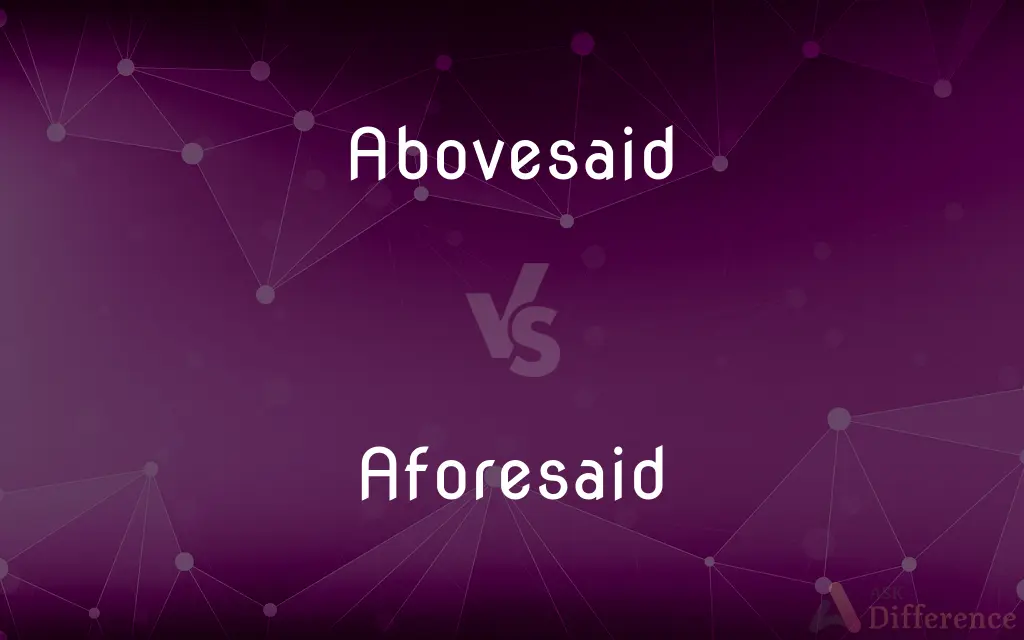Abovesaid vs. Aforesaid — What's the Difference?
By Urooj Arif & Maham Liaqat — Updated on May 7, 2024
Abovesaid and aforesaid are both adjectives referring to something mentioned earlier in a text; abovesaid emphasizes location in the text, while aforesaid focuses more on the mention itself.

Difference Between Abovesaid and Aforesaid
Table of Contents
ADVERTISEMENT
Key Differences
Abovesaid is typically used to refer specifically to something mentioned previously in a document, emphasizing its position above the current reference point. Whereas aforesaid also refers to prior mentions, but with an emphasis on the reference being formally acknowledged before in the discussion.
Abovesaid often appears in legal or formal documents to denote elements that have been discussed in the preceding text. On the other hand, aforesaid tends to be used more broadly in legal contexts to indicate any prior mention that is legally binding or significant, regardless of its position.
The usage of abovesaid can serve as a directive to look at a specific part of a text that appears earlier. In contrast, aforesaid acts more as a generic reference, pointing back to a previously mentioned subject without focusing on its exact textual position.
In practical applications, abovesaid is less common today and may appear outdated or overly formal in everyday usage. Conversely, aforesaid, while still formal, is more commonly encountered in legal documents, contracts, and decrees.
Both terms are mainly found in written language and are rarely used in everyday spoken English. Aforesaid, however, retains a slightly more frequent usage due to its common presence in legal and formal writings.
ADVERTISEMENT
Comparison Chart
Context
Formal, especially legal
Formal, especially legal
Usage Frequency
Less common
More common
Emphasis
Textual position
Prior mention
Modern Usage
Considered outdated
Still in use, though formal
Common Environments
Legal documents
Legal documents, contracts, official statements
Compare with Definitions
Abovesaid
Previously specified within a document.
The abovesaid terms apply to all parties involved.
Aforesaid
Previously mentioned or referred to.
The aforesaid article defines the responsibilities clearly.
Abovesaid
Mentioned earlier in the text.
Refer to the abovesaid clause for more details.
Aforesaid
Referred to in the text before.
The aforesaid examples show typical cases of this issue.
Abovesaid
Noted in the foregoing sections of a text.
As per the abovesaid agreement, the payment was made.
Aforesaid
Mentioned before in a document.
The aforesaid conditions must be met by all applicants.
Abovesaid
Indicated above in a written context.
The abovesaid figures illustrate the trend clearly.
Aforesaid
Discussed earlier, especially in legal contexts.
The aforesaid stipulations are binding for all parties.
Abovesaid
Discussed prior in the text.
The abovesaid arguments are essential for understanding the case.
Aforesaid
Stated or written earlier.
According to the aforesaid rules, this procedure is mandatory.
Abovesaid
Mentioned or recited before.
Aforesaid
Spoken of earlier.
Abovesaid
Mentioned or recited before.
Aforesaid
Previously stated; said or named before.
Aforesaid
Said before, or in a preceding part; already described or identified.
Aforesaid
Being the one previously mentioned or spoken of;
Works of all the aforementioned authors
Said party has denied the charges
Common Curiosities
What is the primary use of abovesaid?
Abovesaid is primarily used in legal or formal documents to refer to something mentioned earlier in the text.
Is aforesaid still relevant in modern writing?
Yes, aforesaid remains relevant, especially in formal and legal writings.
How is aforesaid different from abovesaid in usage?
Aforesaid is used more broadly to refer to anything previously mentioned in a text, not necessarily limited by its position.
What is the advantage of using aforesaid in legal documents?
Aforesaid helps clarify references to earlier mentioned terms or clauses, ensuring legal clarity.
How does the use of abovesaid affect the clarity of a document?
Using abovesaid can enhance clarity by directing the reader to a specific part of the document mentioned earlier.
Why is abovesaid considered outdated?
Abovesaid is seen as outdated due to its less frequent modern usage and very formal tone.
Does the use of abovesaid limit the readability of a text?
It can limit readability for those unfamiliar with formal or legal jargon.
How do modern lawyers view the use of aforesaid?
Many modern lawyers still use aforesaid for its precision and formal appropriateness in legal texts.
Can abovesaid and aforesaid be used interchangeably?
While they can often be used interchangeably in legal contexts, abovesaid specifically points to a higher position in the text.
Where would you typically find the word abovesaid?
Typically, abovesaid is found in legal documents and formal agreements.
Can abovesaid appear in non-legal texts?
Yes, though rare, abovesaid can appear in any formal written text needing precise referential clarity.
Are there modern alternatives to using abovesaid and aforesaid?
Modern alternatives include phrases like "mentioned above" or "previously stated."
Is there a difference in the legal implications of abovesaid and aforesaid?
Legally, both serve similar purposes to refer back to previously stated terms or conditions, without significant difference in implication.
What is a common scenario for using aforesaid?
A common scenario is in legal documents where terms or obligations referenced earlier need to be reiterated for emphasis.
What makes aforesaid preferable in formal communications?
Its formal tone and the legal precision it brings to documents make aforesaid preferable in formal communications.
Share Your Discovery

Previous Comparison
Biathlon vs. Triathlon
Next Comparison
Education vs. EducationalAuthor Spotlight
Written by
Urooj ArifUrooj is a skilled content writer at Ask Difference, known for her exceptional ability to simplify complex topics into engaging and informative content. With a passion for research and a flair for clear, concise writing, she consistently delivers articles that resonate with our diverse audience.
Co-written by
Maham Liaqat















































